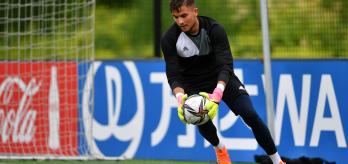Researchers in the Netherlands studied the load in training for 28 elite players in the top division of Dutch football. They quantified metrics including distance, acceleration and deceleration, and how these changed throughout the training week. They also compared the loads of those who would be starting a game and those who would not, in addition to the load differences when there were two games in a week. Dr Stevens presents the study in the presentation below.
Key take-aways
-
The training load of players declines as they get closer to match day.
-
Non-starters estimated lower weekly loads than starters’, so additional training is needed to maintain their physical sharpness.
-
Training load data in relation to reference matches is valuable for data interpretation and training session design.
Watch brief
Read summary
Part 1: Background and Methods
The aim of this study was to quantify training and match loads, across multiple variables, using a local positioning system. A second aim was to compare the loads of players that started compared to those who didn’t start the game. Twenty-eight elite outfield players were monitored during the season. Dr Stevens outlines the different training sessions that take place during the week between match days.
Part 2: Results
There was a decline in training load as match day approached. Dr Stevens explains the differences in load between training days for several metrics, including distance covered across a range of speeds, acceleration, deceleration, and time above 90% of maximum heart rate. High speed running distance in training four days before a game was about 70% of that covered on match day. This value declined in sessions as game day approached. Acceleration and deceleration load in training sessions four days before a match were quite close to that achieved in matches, but this, too, declined the closer a session was to a game. He also revealed the differences in the various metrics between those who started the match and those who did not make the starting 11.
For example for sprint distance, non-starters had a 30% lower load compared to the starters. In weeks with two matches, the sprint load increases slightly for the starters, but is reduced by 80% for the non-starters. Dr Stevens reveals this is because on average there are 18 players in regular training sessions, while there are only 9 or 10 in non-starters sessions the day after the match, meaning the group can only play small-sided games of 4v4 or 5v5 in training, which has a reduced intensity compared to larger formats and matches.
Part 3: Applications
The reduced load for non-starters needs to be addressed, Dr Stevens stresses. This can be done by adding players to training sessions, organising friendlies or having non-starters play with reserve or youth teams. Dr Stevens also highlights the importance of using acceleration and deceleration as load measures. Coaches should choose distinctive training load variables for players, such as cardiovascular load, high speed running distances, and total number of intense accelerations. Being able to express training load data in relation to reference matches is valuable for data interpretation and training session design.
Paper citation and link
Stevens, T.G.A., de Ruiter, C.J., Twisk, W.R., Savelsbergh, G.J.P., Beek, P.J., 2017, “Quantification of in-season training load relative to match load in professional Eredivisie football players”, Science and Medicine in Football, vol. 1, 2: pp. 117-125.
Read the full paper Read the full paper here.








.variant64x64.jpg)


.variant348x164.jpg)

